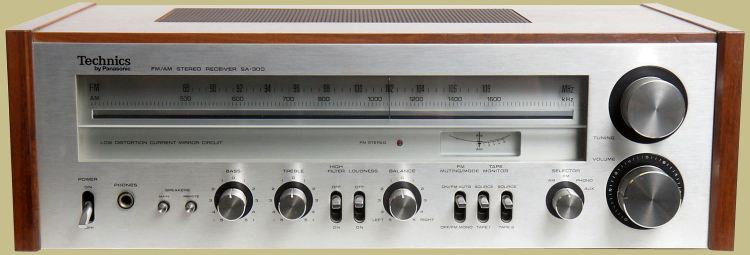
Well, we can’t all be monsters right? The Technics SA-300 is no monster, but it does fulfill its purpose. This little guy produces 35 watts per channel with no more than 0.04% total harmonic distortion. So, with some fairly efficient speakers it can produce some nice clean sound for moderately sized room. Plus, it looks nice too! The brushed aluminum face plate and black inset knobs give it a high end, sophisticated appearance.
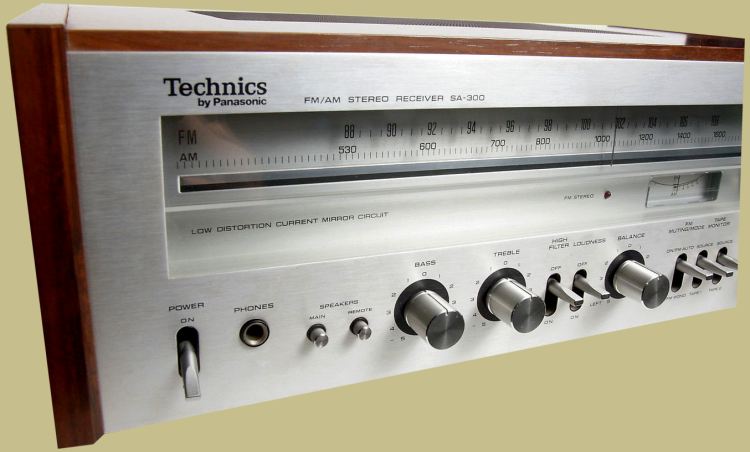
Offered from 1978 until around 1980, the Technics SA-300 retailed for about $300. It features a 41 click step volume control, low distortion bass and treble controls, high filter switch, loudness compensation switch, and dual function tuning meter.
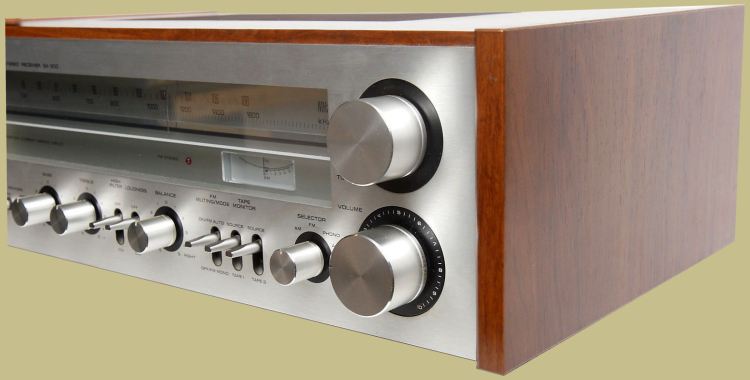
The SA-300 really does look nice when lit up. The amber back lighting of the tuning dial is both clean and elegant.

The output stage on the SA-300 is direct coupled which means it uses no capacitors. This results in a nice, tight, solid bass response right down into the lower frequencies. And, believe it or not, the SA-300’s FM front end utilizes a dual gate MOS FET design and a 3 gang linearly variable tuning capacitor. This gives it excellent sensitivity and interference rejection.
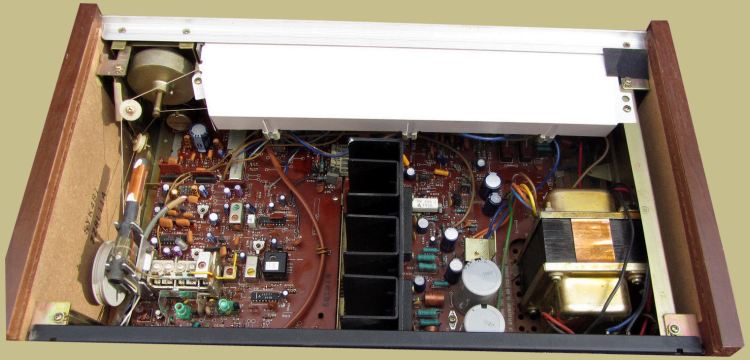
It weighs just over 17 pounds and measures roughly 18 5/16 x 6 x 12. The cabinet has a walnut grain vinyl over pressed wood. The SA-300 is a pretty good little receiver. No, it’s not going to blow the doors off of any room but it will make a good garage or studio unit. Some people feel the sound is nice and clean while others have called it two dimensional.
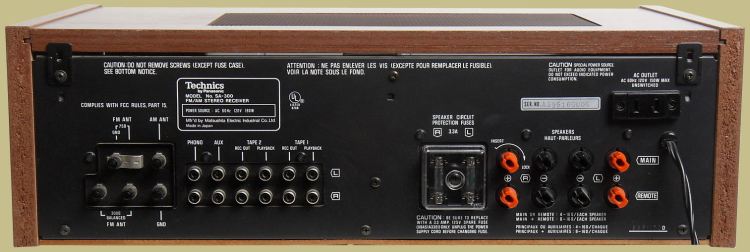
The Technics SA-300 is a decent receiver but it’s not in high demand. It has its place in the vintage audio world as an entry level receiver or everyday workhorse in the garage. It doesn’t handle low ohms well and requires pretty efficient speakers. If you find one at a good price though, it can still be a desirable piece of equipment.

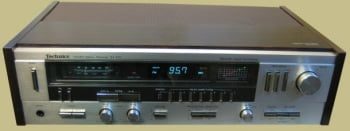
Do you know where I can purchase the 3.3 amp speaker output fuses for the Technics SA-300 receiver?
Thank you
Looks like 3.3 amp aren’t so common. You could try 3.15 amp. It might blow quicker if you really crank the receiver up but they should work. I don’t know what the length of that particular fuse is so you’ll need to measure it in millimeters. HERE are some 3.15A 125V 20mmx5mm fuses on eBay. I’m sure there are some longer versions available as well. RadioShack or Mouser probably have 3.15 amp versions as well. The slightly lower amperage shouldn’t be a problem – they will just blow slightly easier than the 3.3amp versions. Just make sure to match the voltage, which I believe is 125 volt for the SA-300, and the length and width (probably 5mm x 20mm) so that they will fit properly in the fuse holder.
I realize this post is old but others may come here searching for the same…like me!
Regarding the 3.3 Amp fuses, it’s best to err on the side of caution and use a lesser, slightly more common value of 3 Amp. If it keeps popping with any regularity then you might have a short somewhere in the speaker wires.
Got a dog or cat that likes to chew on things?
A couple of years ago I had to replace my (original) fuses, but I inspected the wiring and discovered a shorted speaker. I put in 3 Amp fuses and the receiver has performed flawlessly with regular use. I think I found them at my local, non-bigbox, hardware store for around $6.00.
I have a mint condition sa-300.for $75..
Do tell!
Cory, where is the receiver located?
I have this receiver in great condition except one side of the stereo does not work with the speaker we tried. Is it worth it to fix or should I just sell it cheap? Its been in storage for over 20 years.
thanks
Years ago I had an SA-300 and one of the power amps blew out. I replaced both left and right with RCA Darlington 50Watt power amps. The power supply handled them just fine and the receiver works great to this day.
I myself have a Technics SA-300. The right side just hums and the left works just fine. Being that it has two power amps, i was just wondering which one inside the unit is the right amp that needs replaced. Thank you for any help you all may provide.
Peace
Can’t recall how I became interested in vintage receivers but I now have a SA-300 and a Sansui G 8700db.When I put the 300 with decent speakers and music from bands only, it’s really nice.
Hi there. I have a Technics reciever SA-300 with no sound output in both channels. Only humming in both channels . I found that a resistor R625 (120 ohm) was roasted. So I changed it and now the reciever works in left channel, but still no sound from right channel. Only humming in right channel. I think there is the same problem in the right channel, but I can´t find the faulty resistor . Can anybody help please? Thank you.
Just wanted to correct some misinformation above. The chassis has a measurement of 18 5/16″ across the face. This may affect some folks’ decision as to whether the SA-300 will fit into their shelf unit. I bought one recently and guess what?
On the bright side of things, I want to thank the people on this site for the details they provide on vintage receivers. We owe them a debt of gratitude.
Thanks for the info! I have updated the post with the correct information.
Many years ago one of the Darlington Power Pack amplifier chips fried in the SA-300. At the time, the local electronics outlet (pre-internet) only had ready access to a pair of 50 Watt packs and a long back order on the 35 Watt found in the SA-300. It is still working just fine after all these years and I did borrow it back to do some testing on my vintage New Large Advent Speakers. With a little searching, you can find new Darlingtons. I do recommend replacing with new pairs if that is what the receiver needs. If I remember what my impression was when I first listened after the repair, I recall that when playing at a moderately high volume, the amp handled the transient highs much better than before. No other parts needed to be replaced on the circuit board.
Could you tell me which part number the output chips are? I have an sa 303 and it uses stk1039 Darlington chips.
Hello, I enjoyed this thread. I just brought back my Sa-300 from the dead. Had output in only one channel.
Took a chance and invested 40 bucks in the power amplifier chip module with heat sink. Desolder, swapped out and desoldered. Viola! All is back and it sounds as good as it did in 1978!
I did no real troubleshooting just replaced what I thought the most likely offending component. Hope this helps future restorations. This model in particular is clean sleek and highly underrated. I was going to sell it but now I think I’ll just consider keeping it.
I have one of these that I used as part of a hi-fi setup and for watching movies and playing games when I was a kid. It works, but it’s a little dusty from sitting in a closet for years. I don’t know what to do with it.
The ebay listings showing them going for over $100 are promising, but shipping it would be a hassle because of the weight and bulk of it.
You could try selling it locally on Craigslist, OfferUp or Facebook marketplace. Would save you the hassle of packing it to ship.
Since it’s an old receiver, I assume it has a pre-amp built into it, I’ve never had any output problems playing vinyl records. Only the new digital receivers require an add-on pre-amp, correct? Thanks very much for any input from you all.
I have a Technics SA-300 (still working fine!) that I bought new in a past century and yes, it does have a built-in pre-amp for turntables. There’s a “phono” input on the back (and grounding post for your turntable’s ground wire) as well as an “aux” input for a CD player (or tape, back in the day!). Most affordable stereo receivers had the pre-amp/phono input built-in; only high end audio equipment tended to include separate pre-amps back in the 20th century.